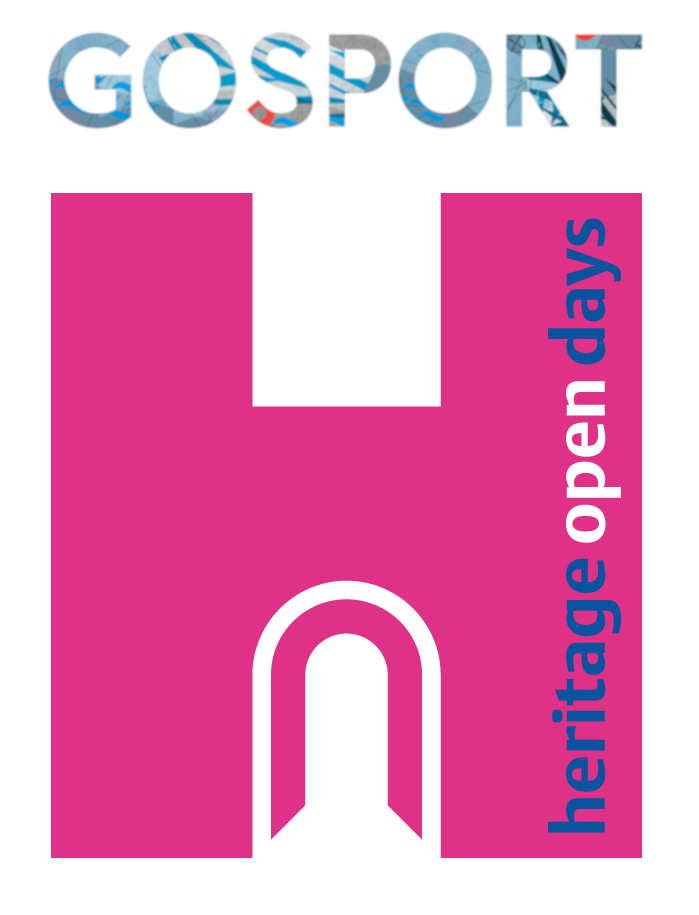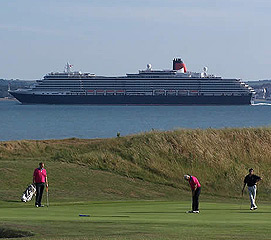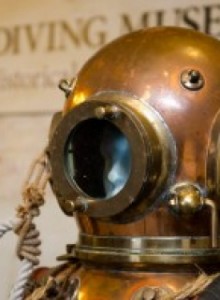http://www.british-history.ac.uk/vch/hants/vol3/pp202-208
The liberty of ALVERSTOKE, including GOSPORT, is bounded on the east by the waters of Portsmouth Harbour, and on the south by Spithead. In the south-east of the district, between the inlets called Forton Lake and Haslar Lake, stands the populous town of Gosport, from which the lines of houses extend northward along the Fareham Road and westward to Alverstoke. To the north are the hamlets of Bridgemary, Elson, Hardway, and Brockhurst, and to the east Forton, now rapidly becoming indistinguishable from Gosport itself.
The land lies low, and where not built over is well-wooded and picturesque, especially on the south-west towards Stokes Bay. The South Western Railway line from Fareham runs through the parishes to Gosport, with two branches, one to Stokes Bay, and the other on the western boundary to Privett, and along the coast to Lee-on-Solent.
In the extreme south angle of the parish is Gilkicker Point with its fort, and close to it on the east is Fort Monkton. Haslar Hospital lies further to the north, close to the mouth of Portsmouth Harbour, where Blockhouse Fort defends the entrance, and the chain which in former days closed the passage yet lies, it is said, in the mud at the bottom of the channel.
Inland, and in the west of the parish are Forts Gomer and Grange, and Brown Down Battery; and Fort Rowner is partly in the parish.
From the shore of Stokes Bay Henry II crossed to France on more than one occasion. East of the village of Alverstoke is Bay House, built in 1838, and now the residence of Mr. Francis Sloane-Stanley. Haslar Hospital dates from the reign of George II, and though of no particular architectural merit, is a good building of its kind, set round a courtyard, with open colonnades and a chapel. It takes its name from a farmhouse once on the site.
There is a ferry from Portsmouth to the end of the High Street of Gosport, a floating bridge capable of taking great weights running every ten minutes to and fro, and the town is intersected with electric tramways. The buildings are in no way remarkable; in High Street, which is the principal road, is a market hall built in 1812, and other public buildings are the free public library, opened 1901, and the Thorngate Memorial Hall, 1885, while in South Street is the Connaught Drill Hall, built in 1902.
MANORS
ALVERSTOKE
ALVERSTOKE was among the possessions of the Old Minster or priory of St. Swithun, Winchester, in Saxon times. It is said to have been bestowed on the minster by a noble Saxon lady, Alwara, for the soul of her husband Leowin.
In 1086 the bishop of Winchester held it for the support of the monks of St. Swithun, to whom it was confirmed by the pope in 1205, and again in 1243; but in 1284, a critical year in the continuous dispute which had been maintained for some centuries between the bishop and the monastery, the manor of Alverstoke with Gosport was transferred to the bishop with two other manors in return for certain important concessions relating to the appointment of obedientiaries and secular servants.
In June, 1284, the king confirmed to the bishop the manors which he had thus acquired from the priory, and a second confirmation of the agreement was issued in the following May. The successive bishops of Winchester retained the manor until, under the Act of 1641 confiscating all episcopal lands, it was seized by the state and sold in 1648 to George Wither, who was noted early in his life for his lyrics, and later for pamphlets in support of Cromwell’s government. At the Restoration the bishops regained their lands, and Alverstoke remained a possession of the see of Winchester until it was taken over by the Ecclesiastical Commissioners.
The tenure of the manor under the monastery and bishops was of a somewhat extraordinary nature, in that the villeins themselves were ‘farming’ the land in 1086. Early in the thirteenth century an agreement was made between the monks and their men of Alverstoke by which the latter promised to pay 4d. an acre yearly for their lands at Alverstoke with the exception of the land lying between the two watercourses, one where the almoner’s mill was situated, and one below the garden of the parson of Alverstoke, for which land 6d. an acre was to be paid by the men of Stokes, Forton, Brockhurst, and Bury. The land for which the extra farm was to be paid was evidently that on which Gosport is now situated, for to the north of Gosport is Forton Lake or Creek, which formerly extended further inland as a mill-pond; and to the south is Stoke Lake, which terminates a little to the south of the church and rectory of Alverstoke.
The same charter recited the privileges allowed to the men of Alverstoke by the prior and monastery: they were to be quit of tallages, pannage, and saltrent; they were to be free to make wills and dispose of their goods; they were to be quit of wards and suit of hundred courts without the manor. At the same time the prior granted that they should hold their lands hereditarily with power to alienate them, and that all pleas save pleas of the crown should be heard without delay in the presence of the prior or his steward at the court of Alverstoke. The charter also regulated the election of the bailiff of the manor. Thus the men of the manor were practically free tenants. They had a common seal which represented St. Swithun as bishop of Winchester seated on a throne holding the pastoral staff in his right hand and in his left a book. The legend is as follows:—
SIGILL’ COMUNE HOMINUM PRIORIS SCtilde;I SWITHUNI DE ALWARESTOKE.
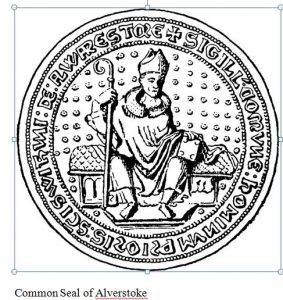
Common Seal of Alverstoke
In 1284, after the priory had transferred Alverstoke to the bishop, the king granted him return of writs in his manor there, and at the same time free warren and freedom from pleas of forest in all his lands.
Disputes between the bishop and his tenants as to their privileges seem to have arisen in 1461 and again in 1606. The bishop or his steward held courtbaron and hundred court every three weeks for the tenants of the manor, while twice a year they also held the tourn, the tenants being quit of the sheriff’s tourn. The courts were occasionally held at the ‘Red Lion’ in Gosport. The bishop also had rights of wreck as lord of the manor, though his claim seems to have been disputed by the lord admiral in 1613.
The bishop’s bailiff or reeve for the manor was always elected in court at the Michaelmas tourn, his chief duty apparently being that of collecting the rents of the tenants. A constable or beadle was also elected at the same time.
BEDENHAM
BEDENHAM (Bedeham, xiii cent.; Badeham, xiv cent.; Bednam, xvi cent.) gives its name to three farms which lie on a broad peninsula to the north of Gosport, at the head of Portsmouth Harbour, where it is joined by the estuary of the Wallington River. Here as elsewhere in the parish the land is level and the chief feature is the wide expanse of the harbour, with Portchester Castle as its most conspicuous landmark. Beyond Bedenham Farm are the Foxbury Brick and Tile Works.
Bedenham was evidently originally parcel of the manor of Alverstoke, but was held in 1303 by John de Drokensford, Keeper of the Wardrobe, who was consecrated bishop of Bath and Wells in 1308. The manor of Bedenham was held of the bishop of Winchester, and is possibly identical with the half hide at Alverstoke held before the Conquest by Sawin and in 1086 by a certain knight. In 1303 John de Drokensford granted the manor together with the advowson of Bedenham church to Roger Lanceleue for life with reversion to John and his heirs.
By 1316 it had reverted to John, who died 9 May, 1329, leaving a brother and heir, Philip de Drokensford, then aged forty. He twice obtained licence for the celebration of divine service in the oratory of his house at Bedenham in Alverstoke, a fact which favours the possibility that the ‘church’ granted with the manor to Roger Lanceleue was no more than a private chapel attached to the manor-house. Philip de Drokensford died in 1356 and is said to have been succeeded by a son and heir John.
In 1370 Margaret, then wife of Maurice le Brun, was holding the manor of Bedenham in dower, perhaps as widow of Philip of Drokensford, of the inheritance of Margaret, then wife of Walter Mildecombe. Walter and Margaret then granted it for life to Maurice le Brun. Later a moiety of the manor was in the possession of Margaret, granddaughter of Philip de Drokensford. Her husband, Peter Courtenay, held a moiety of the manor in her right at his death in 1404, but she survived him and her lands descended to her daughter Elizabeth by a former husband, Sir John de St. Lo.
Elizabeth married Sir William Botreux, on whom the moiety of Bedenham was settled in 1417. Their son and heir Sir William Botreux, knight, held the whole manor jointly with his wife Margaret at the time of his death in 1462. The latter, with her second husband Thomas Burgh, conveyed it in 1464 to certain feoffees, probably in trust, for a moiety was purchased from Margaret Hungerford, daughter and heir of Sir William Botreux, by Robert White of Farnham. After the death of his son John, the possession of this moiety was disputed by Robert and Richard White, sons of John, since Richard, the younger son, claimed that it should descend to him according to the terms of the will of his grandfather Robert. The termination of this quarrel is unknown, but in 1535 Henry White died seised of a moiety of the manor, leaving a son and heir Robert, who settled it in 1546 on Agnes wife of Richard Bennett. She conveyed it to her daughter Margaret Tichborne, at whose death it reverted to John Marriner, son and heir of Agnes. John died in 1593, and his son and heir Peter Marriner together with his wife Dorothy purchased the other moiety from Robert White.
The whole manor thus reunited was bequeathed by Peter Marriner to his only daughter and heir, Mabel wife of Edmund Plowden, who was aged seventeen at her father’s death in March, 1613–14. Within a few years she had parted with it, for in 1624 Robert Bold of Portsea was in possession of it. In 1628 his son William Bold conveyed the manor to his kinsman John Mason, in whose family it remained until 1654, when Robert Tufton otherwise Mason and Anne Gibbon widow were dealing with it, probably for purposes of sale. Before 1683 it was devided into the two farms of Upper and Lower Bedenham. The ‘manor’ was settled by Thomas Beverley on his son Thomas and the latter’s wife Anne in 1713. This Anne survived her husband and was in possession in 1729, after which it appears to have been inherited by coheiresses, Anne wife of John Bonham Smith and Susannah wife of John Carter. Fanny wife of Daniel Carter Hobbs quitclaimed a third of the manor to Anne Bonham in 1782.
Upper Bedenham was bequeathed by Owen Bird to James White of Portsmouth in 1766. In 1774 he bequeathed it to Sir John Carter, who in 1808 held one-sixth, while his son John Bonham Carter had the remaining five-sixths. Lower Bedenham had been mortgaged by Andrew Wall in 1683 and in 1779 was conveyed by James Stares to Sir John Carter. His heirs sold both farms to Mr. Henry Stares in 1868. He conveyed them to Mr. Woodman Hill, from whom they were purchased in 1904 by Mr. Montague Foster of Stubbington House.
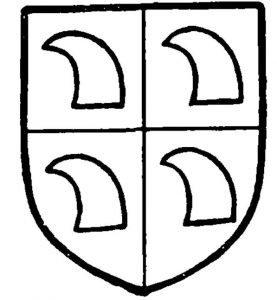
John de Drokeneford, Bishop of Bath and Wells. Quarterly azure and or with four (?) heads of croziers counterchanged.
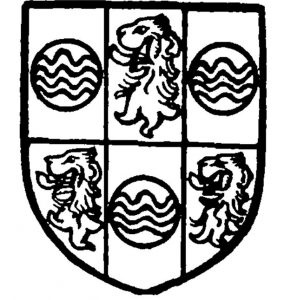
White of Farnham. Six pieces azure and or, in the chief a lion’s head razed gules between two roundels argent, each having two bars wavy vert upon it, and in the foot a like roundel between two of the like lion’s heads.
GOSPORT
GOSPORT (Goseport xiii cent.) covers the district between Forton Lake and Haslar Lake, i.e. the land for which the villeins of St. Swithun paid twopence more the acre than they paid for the rest of the manor. It is not mentioned in the Domesday Book, nor is there any trace of it in the records relating to Alverstoke before the thirteenth century.
In 1284 it was ‘the manor of Alverstoke with Gosport,’ which the monks transferred to the bishop of Winchester, and doubtless before that time Gosport had only existed as a member of Alverstoke, being perhaps the more important on account of its situation at the mouth of Portsmouth Harbour.
In the following century Gosport rather than Alverstoke was the centre of the shipping on the west side of the harbour, for in 1302 Portsmouth and Gosport together were ordered to provide a vessel for the Scotch expedition.
The bishop held separate courts for Alverstoke and Gosport in the thirteenth century, but the profits of both were accounted for by the same two men. During the fourteenth and fifteenth centuries the bishop or his officers held the two yearly tourns at Gosport and at Alverstoke on the same day, but in 1507 and the following 150 years the tourns for both places seem to have been held together, although there were different jurors for each. It is a significant fact that in the court-rolls of Alverstoke and Gosport previous to 1461, the date when the bishop’s tenants obtained an exemplification of the entry relating to Alverstoke in Domesday Book, no record occurs of the election of eparate officers for Gosport, although a bailiff and a beadle were chosen at the tourns at Alverstoke in 1459 and 1461, but that in April, 1462, John Bonsergaunte was chosen to the office of bailiff of Gosport, and did homage to the bishop in the same court for two burgages and eight acres of arable land which he had acquired in the borough of Gosport.
This is the earliest record yet obtained of Gosport as a borough, though under the thirteenth-century charter granted to the men of Alverstoke it enjoyed exceptional privileges. In 1463 the bailiff of Gosport accounted for £6 2s. 8½d. as rent of assize, besides the profits of various vacant sites and the perquisites of the two yearly tourns. In 1648 these rents of assizes or borough rents were of the yearly value of £6 4s. 8¾d. No charter of incorporation has been found, nor does the bishop appear to have granted any special privileges to Gosport.
Early in the sixteenth century Leland described it as a little village of fishermen approached (from Titchfield) by much heathy and fern ground. It was then beginning to rise in importance owing to its proximity to Portsmouth. A block-house and bulwark were raised about the year 1540 for the defence of the harbour, and later in the same century the increased value of the ferry or passage between Portsmouth and Gosport is shown by disputes which arose as to its ownership. It appears to have been held and maintained by the tenants and inhabitants of the borough and town of Gosport. In 1597, however, an attempt was made to prevent its being so casually maintained. It was found to be insufficiently provided with boats, and was taken into the queen’s hands and leased to Stephen Riddlesden and John Jeffries. The inhabitants struggled to retain what appears to have been their only common property of any importance, and in 1602 the lessees were commanded to surrender the ferry to them, and arrangements were made for the provision of twenty boats with a skilful man in each, and the nomination of two supervisors of the passage at each law-day. Nevertheless James I granted the ferry to Edmund Duffield and John Babington in 1614, but they evidently failed to make good their right to it, for the two supervisors continued to be chosen in the borough courts during the seventeenth century.
In 1627 a survey was made of Portsmouth Dock with a view to deciding whether it would not be better to make a new one on the Gosport side. This plan, however, was not carried out, though the town became an important victualling station, and considerable store-houses, timber-yards, and rope-walks were established there in connexion with Portsmouth.
During the Civil War Gosport was held by the Parliamentarians, who set up batteries there which were of great use in the reduction of Portsmouth. The borough had been taken over by the state with Alverstoke Manor, and sold to George and Elizabeth Withers, under whom it appears that no courts were held.
After the restoration of the bishops’ lands only the two yearly tourns were resumed, so that the tenants and inhabitants of Alverstoke and Gosport were obliged to seek justice at Portsmouth. From 1462 onwards a bailiff had been chosen annually at the Michaelmas tourn, together with a constable, and, after 1537, a sergeant. As a rule two men were chosen for each office, but only one was sworn. In 1691 the constable was removed from office by the same court, on grounds of incapacity. No election of a bailiff is recorded on the court rolls after the Restoration; the office had apparently ceased to exist, at least as an elective one.
Finally, in 1682, the corporation of Portsmouth obtained the extension of their borough limits in order to include Gosport. Upon this the freeholders and inhabitants of the manor of Alverstoke and the borough of Gosport petitioned George Morley, then bishop of Winchester, to resume his three-weekly courts, complaining that the mayor and corporation of Portsmouth had encroached upon their privileges by arresting tenants and inhabitants of the borough under warrants from Portsmouth, by forcing several of the inhabitants to serve as jurors there, by sending their officers to survey the weights and measures at Gosport, by taking away the profits of the ferry, by forewarning the freeholders from allowing cattle to graze on the common or from fishing in Oyster Pool Lake, by collecting anchorage in the harbour (an ancient right of the bishop), and by commanding the overseers of the poor to serve a second time.
One of the bishop’s tenants, Albinas Knapton, was fined for protesting against these acts and saying that ‘although the mayor of Portsmouth be mayor of the borough of Gosport, yet he was not mayor of the whole parish of Alverstoke.’ Gosport was again separated from Portsmouth in 1688, when the charter of Charles II to the latter was annulled, but the election of a bailiff in the borough court was not revived, though for a time the constable, coalmeter, ale-taster, and supervisors of the ferry continued to be appointed at the Michaelmas tourn. The two yearly tourns were held as late as 1749, although the business done in them gradually decreased, their work consisting chiefly in the cleansing of the town and the prevention of encroachments. All traces of burgage tenure had by this time disappeared, and before 1749 the courts were known as the courts baron of the manor of Gosport, whereas in 1706 they had been termed the borough courts of Gosport.
In the seventeenth century important ironworks were established in the town, and employed chiefly in connexion with the Portsmouth Docks. Shipbuilding also increased, and the town afforded accommodation for many of the workmen in Portsmouth Docks. These suffered severely in the outbreak of plague which raged in Gosport early in 1666, when numbers of the townspeople left their homes there. For the benefit of the increasing population the bishop of Winchester obtained a grant of two yearly fairs to be held at Gosport on the feasts of St. George and St. Michael, and three weekly markets on Tuesdays, Thursdays, and Saturdays. This grant to the bishop is dated 1717. The fairs had much deteriorated in the nineteenth century, when toys were the only articles sold in any quantity. The dates were also changed to 4 May and 10 October. They were finally abolished under an order in council in 1900. The old market-house stood in the High Street, but in 1812 the present market-hall was built near the beach, and the markets were held outside. No market has been held during the last fifty years.
In 1763 a board of trustees for paving Gosport was appointed, and in 1814 a more effectual Act was passed for the watching, lighting, and paving of the town. Both Acts were partially repealed in 1874, when Gosport was included in the urban sanitary district of Alverstoke, which adopted the Public Health Act of 1875 in 1887, and since 1894 has been formed into the Gosport and Alverstoke Urban District Council.
During the wars of the eighteenth century the population increased rapidly, but the prosperity of the town diminished after the restoration of peace, until the transfer of the victualling establishment to the Royal Clarence Yards again revived it.
CHURCHES
The church of OUR LADY, ALVERSTOKE, has been gradually rebuilt, and it is now entirely modern, with a chancel erected in 1865, a nave of five bays built in 1885, and a west tower. The old church, of which a plan is preserved in the library of the Society of Antiquaries, was of the same general plan, with north and south chapels added to the nave in the early part of the nineteenth century. The present church contains a number of monuments from the former building, and stands well in a large churchyard, but is of no antiquarian interest. In the west tower are two bells from the old church, dated 1699 and 1766, and the church possesses a silver paten of 1702, and cup of 1783, the rest of the plate being quite modern—a silver chalice of 1901, a silver-gilt chalice of 1875, and paten of 1880, and a silver paten of 1838, besides a glass flagon with plated mounts.
The registers begin in 1559, the first book running to 1686, and the second to 1737 for baptisms, 1714 for burials, and 1710 for marriages. The third volume continues the baptisms and burials to 1801, and the marriages to 1763, and the fourth takes the baptisms and burials to 1812. The marriages from 1763 to 1812 are contained in no less than seven books, beginning in the years 1763, 1765, 1777, 1784, 1791, 1799, and 1809.
No church is mentioned in the Domesday Survey. In 1122 William Giffard, then bishop of Winchester, disputed with the prior of St. Swithun the possession of nine churches attached to the manors held by the monks. Among these was Alverstoke church, which the bishop restored to the monks in 1124.Thenceforward the history of the rectory was coincident with that of the manor until the latter was transferred to the Ecclesiastical Commissioners while the bishop retained the rectory and advowson. Apparently they were not appropriated to the prior or the bishop. A pension from the church was assigned to the hospital of St. Cross at Winchester, and is still paid. The bishop had within the parish a peculiar court, the records of which commence in 1612, and are deposited at Winchester.
There are now two chapels-of-ease attached to St. Mary, Alverstoke—one, under the invocation of St. Mark at Anglesey, was built in 1844 ; the other, Christ Church at Newton, is a modern building enlarged in 1862, and has a chancel with nave of four bays.
There was a chapel at Gosport attached to the parish church in 1284. Leland states that there stood, before his time, a ‘prophanid’ chapel near the shore of Portsmouth Haven, ‘scant half a mile from the very mouth of the haven.’ The present church of the Holy Trinity was built in 1696; for some years it was a chapelry of St. Mary, Alverstoke, but it was assigned a separate parish in 1860. St. Matthew, Gosport, was formed into a parish out of Alverstoke in 1845,the church being built in the same year. Holy Trinity Church is a brick building stuccoed, consisting of chancel, nave with aisles of eight bays, west porch, and detached north-west tower. It was entirely remodelled in 1887, and the west end rebuilt, the tower being added in 1889. It contains a great deal of good modern woodwork and other fittings, and the organ came from the chapel at Canons, Stanmore, the famous house of the dukes of Chandos, having been purchased by the parishioners when the house was dismantled. St. Matthew’s, built in 1846, has a chancel, nave with aisles of five bays, and south porch, of thirteenth-century style.
The church of St. John, Forton, was built in 1831, to serve as a district chapel. In 1841 a distinct parish was assigned to it. A new church is partially built, though the old one still exists.
At Elson the church of St. Thomas was built in 1845, and assigned a portion of Alverstoke parish in December of that year. It has a chancel, nave, and west turret, and is designed in thirteenth-century style.
The Baptists, Congregationalists, and Wesleyans all have chapels in Gosport, and the Roman Catholics have a chapel in High Street.
CHARITIES
The following charities exist within the liberty:—
Captain John Mann, by his will 1660, gave £5 yearly for the poor out of certain messuages in George Alley, in the parish of St. George, Southwark, vested in the governors of St. Thomas’s Hospital, from whom the sum of £4 is received annually—£1 being deducted for land tax.
In 1671 Abraham Hewlett by will gave 20s. yearly to the poor out of his dwelling-house in Gosport. The annuity is secured on a house in High Street, Gosport, and is regularly paid by the owner.
In 1711 Jane Holmes by will charged a house and garden with 40s. yearly, for the benefit of two poor widows. The annuity is regularly received from Mrs. Seward, the owner of the house in the village. Two cottages adjoining the property charged are occupied by two widows, who in addition to the annuity of 40s. receive £36 8s. from the Thorngate Charity No. 4 (see below).
William Allen, by will 1719, charged his estates in Gosport and Alverstoke with £4 a year for the poor. It is secured on the King’s Arms publichouse, High Street, Gosport, and is received from Messrs. L. N. Blake & Co., solicitors for the owner.
In 1773 William Poore, by his will, charged his house in Gosport with £5 yearly for ever, payable to the churchwardens of the liberty part of the parish of Alverstoke for bread, to be given after every Sunday morning’s service to poor persons therein, widows in preference. The devise was confirmed by deed enrolled in Chancery, dated 2 October, 1775. The rent-charge fell into arrear, but, owing to the intervention of the Charity Commissioners, the payment was resumed (with arrears) by the owner of No. 30, Clarence Square, Gosport, which represents the property charged.
In 1828 James Spaycock by his will left £78 11s. consols (with the official trustees), dividends to be given to two of the poorest and most respectable watermen residing in the parish.
The above-mentioned charities are administered together by the rector and churchwardens. Bread is given weekly to aged widows, fourteen old widows receive 5s. each, and the dividends on the stock are divided between two poor old watermen.
In 1880 Thomas Paul by will left £3,000 consols to the rector and churchwardens of Alverstoke, the dividends to be applied in the distribution of coals at Christmas-time to poor residents in the parish without regard to age, sex, or religious profession, in quantities of one-fourth of a ton to each person. In 1905, 78 tons of coal were distributed among 312 recipients at a cost of £73.
In 1887 Frederick John Lowes, M.D., bequeathed £1,000 consols to the rector and churchwardens upon trust, that the dividends thereof should be applied in the distribution of money at Christmas among fifty poor inhabitants residing in the parish as constituted in the year 1887, when the charity came into operation. The sum of 10s. is given to each recipient.
The two sums of stock are held by the official trustees.
The above apply to the whole parish of Alverstoke. In connexion with the town of Gosport there are the following charities:—
By deed dated 27 September, 1693, Lambert Peachey conveyed a piece of land for the erection thereon of almshouses. Augmentations were made to the charity by members of the Peachey family, and in 1786 a sum of £360 arising under the will of Richard Pilfold (1760) was laid out in the purchase of 3 acres 2 roods in the parish of Wickham, the rents to provide weekly bread for the inmates.
The endowments of the Almshouse Charity now consist of a messuage in North Cross Street, let at £40 a year; an annuity of £2 10s. paid by the Urban District Council out of New Short Road, Gosport; and £78 0s. 4d., £2 15s. per cent. annuities, arising from investment of balances in hand.
The endowments of Richard Pilfold’s augmentation consist of 2 acres 20 poles of land at Wickham, £196 19s. 4d., £2 15s. per cent. annuities, arising from investment of proceeds of sale in 1899 of part of the land at Wickham to the London and South Western Railway Co., and £96 10s. 4d. consols from investment of surplus income. The sums of stock are held by the official, and the charities are administered under a scheme of the Charity Commissioners, dated 15 May, 1900.
In 1838 Mrs. Ann Paul, by will proved in the P.C.C., left £200 to be invested and income applied (subject to an invalid trust for repair of certain tombs in the chapel-yard of Holy Trinity), to be divided on 1 February and 1 August in every year among indi gent widows. The legacy was invested in £20 10s. 6d. consols with the official trustees.
The Thorngate Almshouses at Brockhurst:—
Thorngate Charity No. 1—
By deed dated 6 March, 1866, John Batty Thorngate and William Thorngate conveyed to trustees a piece of land at Brockhurst, upon which ten almshouses had been erected for the occupation of ten females (spinsters or widows), and endowed the same. The present endowment consists of £2,409 18s. 8d. consols. In 1905, £52 was expended out of the dividends of the stock in weekly payments to the inmates. (See also Thorngate Charities, Nos. 3 and 5.)
Thorngate Charity No. 2—
By deed dated 11 March, 1867, the said William Thorngate conveyed to trustees a piece of land at Camden Town, Forton, upon which fifteen almshouses had been erected, and endowed the same with £7,500 consols. In 1905 the sum of £155 12s. out of the dividends of this sum of stock was expended in weekly payments to the inmates. (See also Thorngate Charities, Nos. 3 and 5.)
Thorngate Charity No. 3—
By another deed, also dated 11 March, 1867, William Thorngate settled a sum of £42,000 consols upon trust to provide certain fixed payments to certain institutions and schools and poor persons within the parish of Alverstoke, and certain institutions not within the parish. The stock, which is held by the official trustees, has, as regards the educational charities, been apportioned by an order dated 10 April, 1906, made by the Charity Commissioners under the Board of Education Act, 1899.
For Cook’s Ragged School and Home in South Street, established in 1853 (now known as ‘The Henry Cook Institute and Boys’ Home’), a sum of £1,200 consols has been set aside to produce £30 a year. To produce £10 a year for each of the following institutions, viz.:—The Sunday School at Alverstoke; the Sunday School at Elson; the Ragged School, Haslar Street, Gosport; Holy Trinity Sunday School; St. Matthew’s Sunday School; and Forton St. John Sunday School, six sums of £400 consols have been set aside as educational foundations in connexion with each of these objects.
In 1905 the sum of £78 was paid to the inmates of the ten almshouses at Brockhurst (Charity No. 1); and £64 15s, to the fifteen almshouses at Gosport (Charity No. 2).
Thorngate Charity No. 4—
By deed dated 24 August, 1867, William Thorngate and Emmanuel Churcher conveyed to trustees land at Camden Town, Forton, for the erection of forty or more three-roomed almshouses for married couples or females above fifty years of age, for the endowment of which certain securities were assigned by deed 4 February, 1868. (Thorngate Charity, No. 5).
In 1905 the endowment fund consisted of £71,940 13s. 7d. consols (with the official trustees), the income of which is applicable by the trustees in annual specified subscriptions to numerous existing educational and charitable societies and institutions, with power for the trustees to retain £120 per annum for their expenses in executing the trusts. In 1905 the payments for local objects included Gosport and Alverstoke Victoria Nursing Institution, £10; to inmates of two almshouses (Jane Holmes), Alverstoke, £36 8s.; to inmates of ten almshouses at Brockhurst, £52 (Charity No. 1); to inmates of almshouses at Gosport, £51 16s. (Charity No. 4); to inmates of fifteen almshouses, Camden Town, £116 14s. (Charity No. 2); sixty poor people also received £10 each, twenty-one received £15 each, and ten received £5 each; £20 were paid to four poor old watermen, and £20 to four poor old fishermen.
Thorngate Charity, No. 6—
By deed dated 22 January, 1868, William Thorngate conveyed to trustees certain messuages, tenements, and lands, and assigned certain bonds and securities upon the charitable trusts therein mentioned, namely, for the benefit of poor persons resident in the town of Gosport and elsewhere in Great Britain and Ireland. Under the authority of an order of the Charity Commissioners, dated 4 July, 1890, several pieces of land (part of the trust property), containing together 96 acres 2 roods 20 poles, situated at Hoe Gate, in the parish of Soberton, were sold, and the net proceeds, amounting to £1,908 1s. 2d., were invested in New South Wales 4 per cent. stock. The endowment (1905) consists of four freehold tenements in Gosport, producing about £50 a year; a rentcharge of £20 on land known as the Gurnard Estate, in the Isle of Wight (about to be redeemed); £3,072 4s. 2d. Queensland 4 per cent. stock; £4,692 11s. 7d. New South Wales 4 per cent. stock; £5,561 3s. 4d. New Zealand 4 per cent. stock; and £644 7s. 6d. Canada 3½ per cent. stock, producing £550 a year. In 1905, £300 was expended in donations of £20 each, and £200 was distributed in fuel, meat, and other necessaries to 500 people; and £100 was, as directed by the deed, retained by the trustees.
The several sums of stock belonging to the abovementioned Thorngate Charities are held by the official trustees.
Thorngate Charity No. 7 was founded by deed dated 4 January, 1868, whereby certain freehold and leasehold property in Ireland (including a fee-farm rent of £89 10s. 9d. issuing out of the lands of Bredagh, in the barony of Kilconnell, in the county of Galway), were settled upon trust to apply the rents in sums of £20 to decayed and unfortunate tradespeople or other persons of Gosport and elsewhere. By an order of the Charity Commissioners dated 26 June, 1906, the trustees were authorized to sell the said fee-farm rent for £2,300, the price fixed in accordance with the provisions of the Irish Land Act, 1903. The particulars of the trust estate have not yet been supplied to the Charity Commissioners.
In 1885 a memorial hall was erected in the High Street, Gosport, at a cost of about £9,000, as a memorial to the late William Thorngate, esquire, merchant of this town, who died in the year 1868, the founder of the several Thorngate Charities.
The Gosport Royal Marine School dates from 1850. An elementary school was opened at Forton in 1830, and another at Gosport in connexion with Holy Trinity Church in 1831. In 1842 a school was founded at Alverstoke, and about two years later St. Matthew’s School, Gosport, and Elson School, were opened. In 1853 an elementary school was founded at Newton, and another in connexion with the Roman Catholic Church of St. Mary was established in 1811. Leesland School was opened in 1850.
